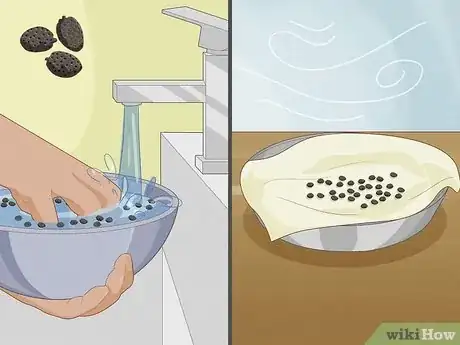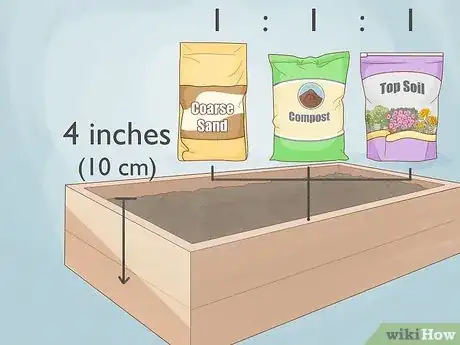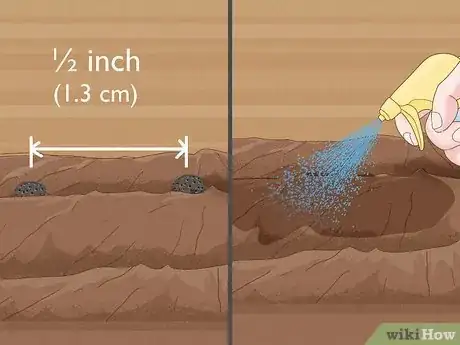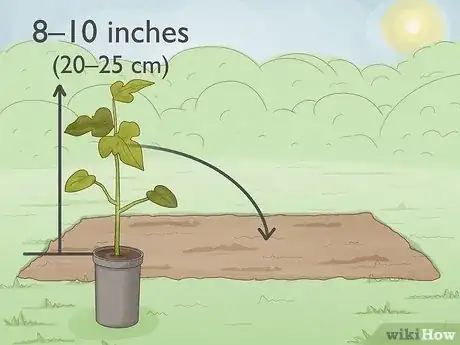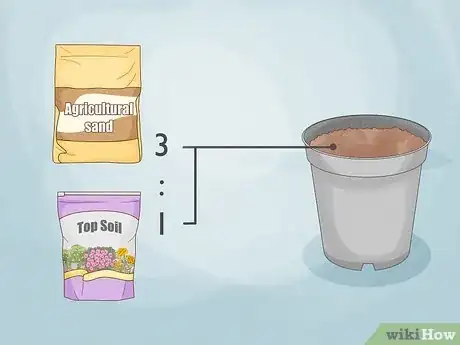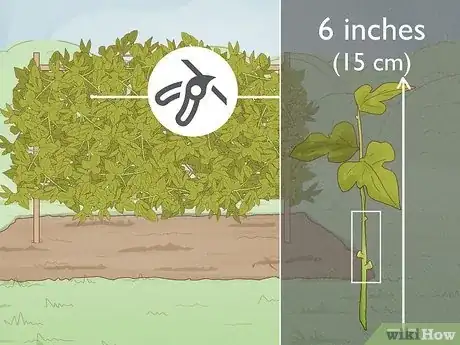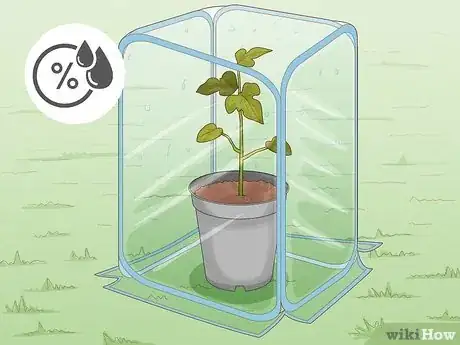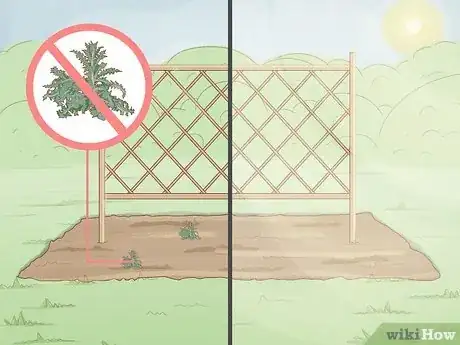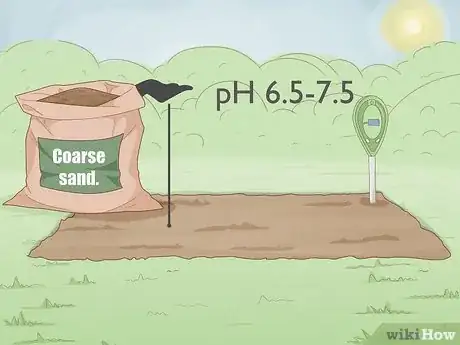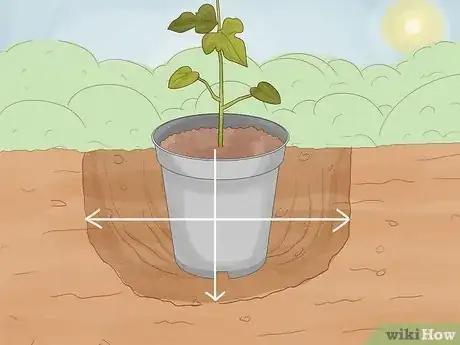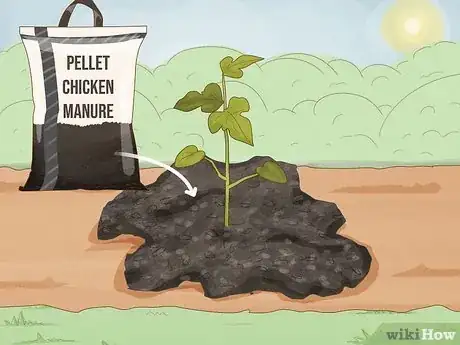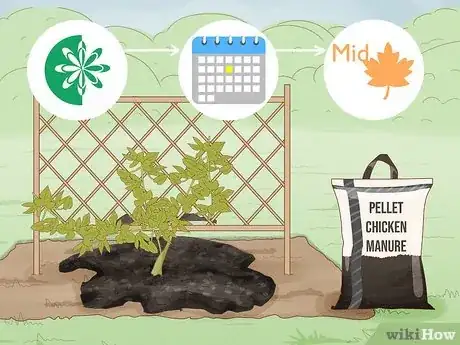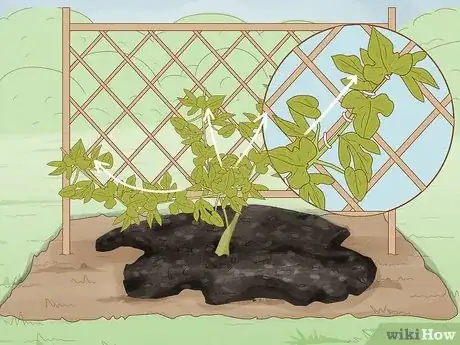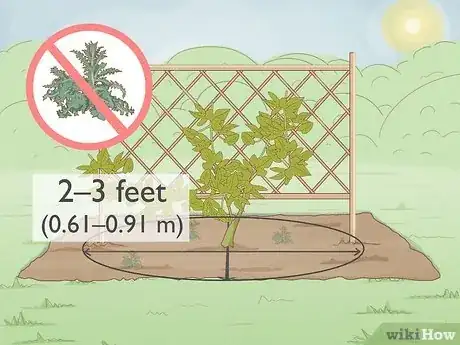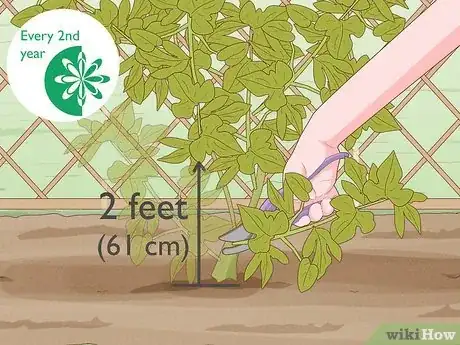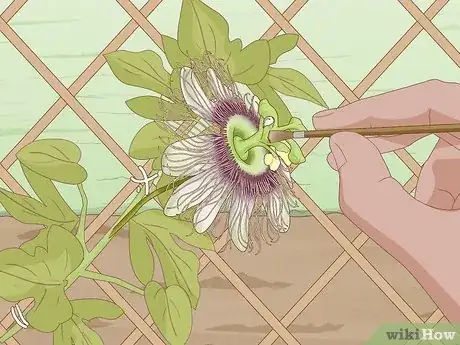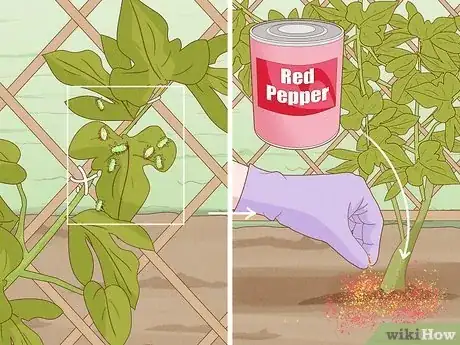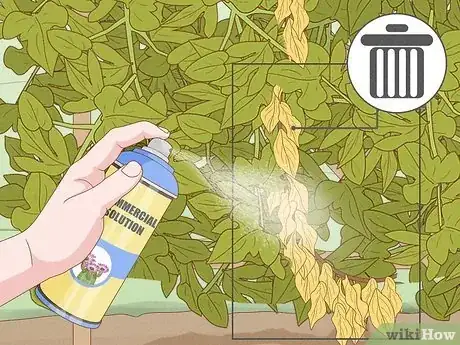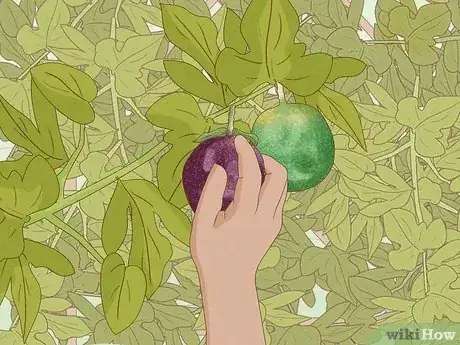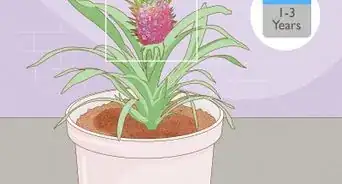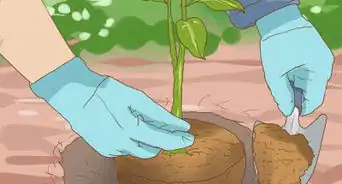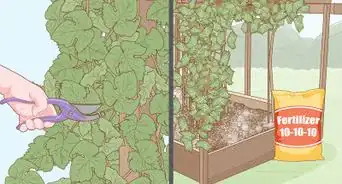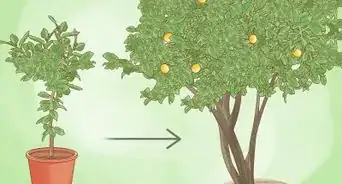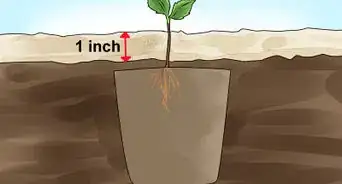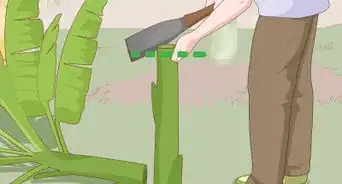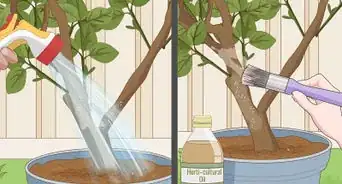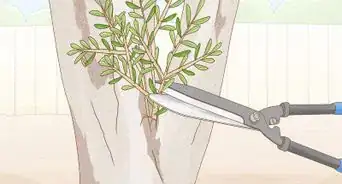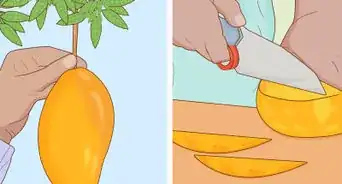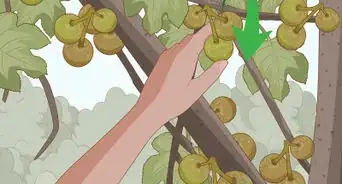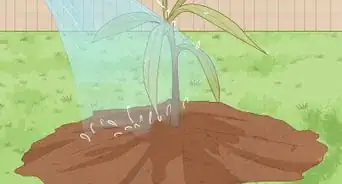This article was co-authored by Lauren Kurtz. Lauren Kurtz is a Naturalist and Horticultural Specialist. Lauren has worked for Aurora, Colorado managing the Water-Wise Garden at Aurora Municipal Center for the Water Conservation Department. She earned a BA in Environmental and Sustainability Studies from Western Michigan University in 2014.
wikiHow marks an article as reader-approved once it receives enough positive feedback. This article received 24 testimonials and 100% of readers who voted found it helpful, earning it our reader-approved status.
This article has been viewed 417,960 times.
If you live in a warm climate and do not experience harsh winters, you can grow tropical passion fruit at home. The plant can be a little finicky and needs room to spread out, but with enough attention and care, it will provide you with a steady yield of delicious fruit.
Steps
Starting from Seed
-
1Use fresh seeds. Freshly harvested passion fruit seeds germinate quickly, but older, dry seeds can take months to germinate if they grow at all.[1]
- A few days before you intend to plant the seed, buy ripe passion fruit from the store. Open it and collect at least 6 seeds.
- Spread the seeds out onto burlap and rub them until the juice sacs burst open.
- Wash the seeds in water and allow them to dry for 3 to 4 days before washing them again and drying them in the shade.
- If you plant the seeds immediately, they should germinate within 10 to 20 days.
- If you need to store the seeds, place them in airtight plastic bags and refrigerate them for up to 6 months.
-
2Prepare a nursery container. Ideally, you should start passion fruit vines in a separate, protected container and later transplant them to your prepared garden spot. Choose a container that is no larger than 3 square feet (0.28 m2).
- Fill the container with a soil mixture made from equal parts compost, topsoil, and coarse sand. Fill the container with 4 inches (10 cm) of this mixture.
Advertisement -
3Dig shallow furrows. Scrape a stick through the soil in your nursery container, spacing the resulting furrows2 inches (5.1 cm) apart.
- These furrows will serve as shallow drains that can help prevent moisture from drowning the seeds or their budding roots.
-
4Sow the seeds. Place the seeds 1⁄2 inch (1.3 cm) apart from one another inside each furrow. Protect the seeds by covering them with a very thin layer of your soil mixture.
- Immediately water after planting the seeds. Moisten the soil, but do not drench it.
- After planting the seeds, all you need to do is provide an occasional sprinkle of water when the surface of the soil dries out.
-
5Transplant the seedlings. When the seedlings grow to a height of 8–10 inches (20–25 cm), they are ready to be transplanted into a permanent location in your garden.
Starting from Cuttings
-
1Prepare a sand bed. Fill a plastic flower pot with a mixture made of 3 parts agricultural sand and 1 part topsoil. Mix the soil components well so that they are evenly dispersed throughout the container.
- Cuttings get most of the moisture they need to grow from humidity since they do not have roots at this point. As such, you do not want to use a soil that will retain a lot of moisture.
-
2Take a cutting. Choose a mature, healthy passion fruit plant to take a cutting from. Snip off a portion of the vine that contains at least 3 buds or at least 6 inches (15 cm) long, if not more, and cut directly below the lowest bud.
- Newer growth is more active, so it is recommended that you choose a newer portion of vine rather than an older portion.
- Immediately plant this cutting into your sand bed.
- Remove the bottom-most leaves to help your cutting preserve water.
-
3Keep the cutting in humid conditions. The best place for a vine cutting is a greenhouse. If you do not have access to one, though, you can build a humidity chamber by stretching clear plastic sheeting across a box frame made of bamboo.
- Make sure that any humidity chamber you use stays moist. Keep it in full sun, and place it where the air is moist.
- If you need to generate additional humidity, you can do so by running a humidifier or by placing dishes of water-covered gravel around the base of the cutting.
-
4Transplant your seedling once roots form. Your cuttings should form new roots within several weeks if they’re kept in the right condition. They are ready to be treated as established seedlings at this point and may be transplanted into a permanent garden space.
Transplanting Seedlings
-
1Choose the right location. Ideally, you should find a spot that receives full sun and one that does not have any competitive roots, like tree roots, nearby.[2]
- "Full sun" means a full 6-8 hours of sunlight daily, if not more.
- The area should also be free of weeds. If there are a few weeds, make sure that you remove them before planting.
- The vines need space to climb and spread, as well. Ideally, you should look for climbing structures already set in place, like a wire fence, balcony, or pergola. If none of these are available, you could install a trellis, instead. If the vines have nothing to climb, they will start wrapping around the tree.
-
2Amend the soil. Passion fruit needs light, deep soil that contains plenty of organic material. The stuff in your yard probably is not of high enough quality to do the trick on its own, so you'll need to make a few improvements before you can plant either seeds or vines.
- Mix the soil with compost before you do any planting. Compost improves both the texture and nutritional value of the soil. You could also try organic rotten manure, leaf mold, or other green plant waste.
- If the soil is especially dense, you could lighten it by mixing in a handful of coarse sand.
- Pay attention to the pH of the soil, as well. The pH should be between 6.5 and 7.5. If the soil is too acidic, mix in ground dolomite or agricultural lime.
- Add compost to your soil every year to keep it regularly amended.
- Mix organic matter or sand into your soil to keep it well-drained.
-
3Transplant each seedling into a large hole. Dig a separate hole for each seedling. Each hole should be twice as wide as the current width of your plant, and the depth should be at least as deep as the container your seedling currently rests in.
- Carefully dig or slide the passion fruit seedling and its root system out of the container.
- Place the root system in the center of the hole, then loosely fill in the rest of the hole with soil until the plant feels secure.
- Handle the roots as little as possible during the transfer. The roots are very sensitive, and if you damage them during the process, you could destroy the plant.
-
4Mulch and fertilize around the plant. Spread pellet chicken manure or another organic, slow-release fertilizer around the base of the plant. Also spread an organic mulch, like straw or wood chips, around the base of the plant.
- The entire root system needs access to the fertilizer and mulch. For best results, gently push or dig some of the cover into the top layer of the soil after spreading the fertilizer and mulch around the plant's base.
-
5Water well. Use a watering can or garden hose to gently water the seedlings after they have been planted. Make sure that the soil is very moist, but do not allow muddy puddles to form, since this could be an indication that you have provided more water than the soil can absorb and drain.
Daily and Long-Term Care
-
1Feed your plants regularly. Passion fruit plants are heavy eaters, so you will need to provide plenty of water and fertilizer throughout the growing season.
- You should apply fertilizer in the spring and once every four weeks throughout the summer season. A final feeding should also be done in the mid-autumn. Use organic, slow-release fertilizers that are low in nitrogen. Chicken manure pellets are a good option.
- If the area you live in gets plenty of rainfall, you might not need to water the plant too often. If you are going through a drought, though, or if you only live in moderately moist conditions, you will need to water the vine at least once a week. Never allow the surface of the soil to completely dry out.
-
2Train the vines. As the vines spread out, you may need to train them to climb up along your fence, trellis, or other support structure. The plant will be healthiest if the vines are encouraged to climb, and a healthy plant will produce the greatest yield.
- Training the vines is a fairly simple process once you get the hang of it. When fresh vines or feelers begin to stretch out, tie the vine around its base and around the wire of your structure using thin rope or string. Keep the knot loose to avoid choking the vine.
- When the plant is new, lateral branches that come from the main stem should be nipped off to the level of the wire. The two side branches coming from the main stem should then be bent around the top wire of your structure and forces to grow in opposite directions.
- Once the side branches are spread apart, lateral branches can develop from them and hang down loosely.
-
3Weed around the plants. Since passion fruit plants require so much food and water, the enriched soil often becomes a target for unwanted weeds. You need to remove as many of these nearby weeds as possible so that resources are not being directed away from the passion fruit plant.
- Keep 2–3 feet (0.61–0.91 m) of space around each side of the vine base weed-free. Use organic methods of weed removal and do not use chemicals. Mulch can help prevent weeds from shooting up out of the ground, and hand-pulling weeds that do sprout is another good option.
- The rest of the garden can have other plants and weeds in it, but you should keep away plants that could spread disease or attract pests. Legume plants, in particular, are dangerous to keep around passion fruit plants.
-
4Prune as needed. The main reasons for pruning the plant are simply to keep the vines in check and to provide adequate sunlight to the lower portions of the plant.
- Prune in the spring every second year. Make sure that you do so before the plant flowers. Pruning after flowering has occurred can weaken the plant and limit its fruit yield.
- Use shears to cut away branches that are below 2 feet (61 cm). Doing so clears away weak, old growth while also improving air circulation around the bottom of the plant.[3]
- When pruning, make sure that you are not removing a major branch by following the stem along to its base before you cut it away.
- Leave three to five nodes near the base of a branch when you cut it off. New growth can emerge from the stump this leaves behind.
-
5Assist in the pollination process, if necessary. Usually, bees will take care of the pollination process without any additional help from you. If there are no bees in your area, though, you might need to do some work yourself.
- To hand-pollinate the plants, take a small, clean paintbrush and collect the pollen from male flowers. Wipe the collected pollen onto female flowers using the same brush.
- You could also touch the anthers and stigmatic surfaces of each flower with your thumb and index finger as you walk along the rows.
-
6Protect the passion fruit from pests. You should not use insecticides until you identify the early stages of a pest problem. When you do use pesticides, use organic options since chemical options can ruin the fruit produced and make it unsafe for consumption.
- The biggest pest-related problems are aphids, vine girders, and coleopteran beetle larva.
- Aphids can usually be discouraged by sprinkling red pepper around the base of the plant or by spraying them with a focused stream of water from your hose.
- Get rid of vine girders by mixing an organic insecticide in a tar base. Spread this solution around the base of the main stem, and get rid of damaged vines.
- To get rid of beetle larva, you will need to use a systemic insecticide before the plant goes to flower.
- The biggest pest-related problems are aphids, vine girders, and coleopteran beetle larva.
-
7Protect the plant from disease. There are a handful of diseases you should try to prevent. When you spot signs of plant disease, you also need to do what you can to get rid of it and prevent the disease from spreading.
- Passion fruit vines can fall victim to rot and viral diseases.
- Cellar rot and root rot must be prevented ahead of time by providing adequate soil drainage.
- You can attempt to treat virus-infected plants with a commercial solution, but usually, you will need to cut off and burn the affected vines in order to preserve any of the remaining plants. Passion fruit mottle virus, passion fruit ringspot virus, and cucumber mosaic virus are your most common threats.
- Passion fruit vines can fall victim to rot and viral diseases.
-
8Harvest the fruit. It can take a year to a year and a half before your plant will produce any fruit, but once it does, you can harvest this fruit and eat it.[4]
- Typically, ripe passion fruit will drop from the vine as soon as they are ready for consumption. The drop itself does not hurt the fruit, but you should collect the fruit within a couple of days after it drops to ensure the best possible quality.
- If you have a variety that does not drop its fruit, simply pluck off each fruit once you notice the skin beginning to wrinkle.
Expert Q&A
Did you know you can get expert answers for this article?
Unlock expert answers by supporting wikiHow
-
QuestionHow much humidity is required for a passion flower?
 Lauren KurtzLauren Kurtz is a Naturalist and Horticultural Specialist. Lauren has worked for Aurora, Colorado managing the Water-Wise Garden at Aurora Municipal Center for the Water Conservation Department. She earned a BA in Environmental and Sustainability Studies from Western Michigan University in 2014.
Lauren KurtzLauren Kurtz is a Naturalist and Horticultural Specialist. Lauren has worked for Aurora, Colorado managing the Water-Wise Garden at Aurora Municipal Center for the Water Conservation Department. She earned a BA in Environmental and Sustainability Studies from Western Michigan University in 2014.
Professional Gardener
-
QuestionWhen is the right season to plant passion fruit?
 Lauren KurtzLauren Kurtz is a Naturalist and Horticultural Specialist. Lauren has worked for Aurora, Colorado managing the Water-Wise Garden at Aurora Municipal Center for the Water Conservation Department. She earned a BA in Environmental and Sustainability Studies from Western Michigan University in 2014.
Lauren KurtzLauren Kurtz is a Naturalist and Horticultural Specialist. Lauren has worked for Aurora, Colorado managing the Water-Wise Garden at Aurora Municipal Center for the Water Conservation Department. She earned a BA in Environmental and Sustainability Studies from Western Michigan University in 2014.
Professional Gardener
-
QuestionHow long does it take to get the fruit?
 Community AnswerIt takes 18 months, on average,for a new plant. Sometimes, well taken care of plants will bear fruit in approximately one year.
Community AnswerIt takes 18 months, on average,for a new plant. Sometimes, well taken care of plants will bear fruit in approximately one year.
Things You'll Need
- Ripe passion fruit (if collecting seeds)
- Mature passion fruit plant (if collecting cuttings)
- Container for nursery or sand bed
- Knife or garden shears
- Burlap
- Plastic sheeting
- topsoil
- Sand
- Compost
- Shovel or trowel
- Organic pellet fertilizer
- Watering can or garden hose
- Trellis or other support
- Small paintbrush (for pollinating)
- Insecticide (as needed)
References
About This Article
To grow passion fruit, buy a ripe passion fruit and collect at least a half dozen seeds. Spread the seeds out and rub them with your hands until the juice sacs burst open. Then, wash the seeds and allow them to dry for 3-4 days. You can then plant your seeds ½ inch apart in a nursery container filled with compost, topsoil, and coarse sand. Once the seedlings grow to 8-10 inches tall, you can transplant them to your garden. To learn how to grow passion fruit from cuttings, keep reading!
